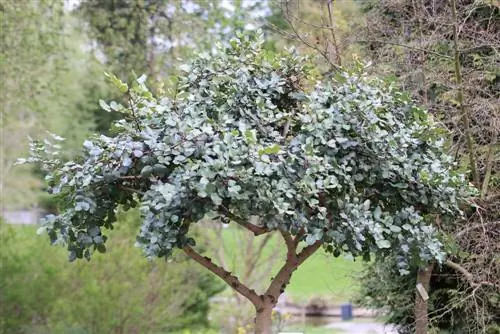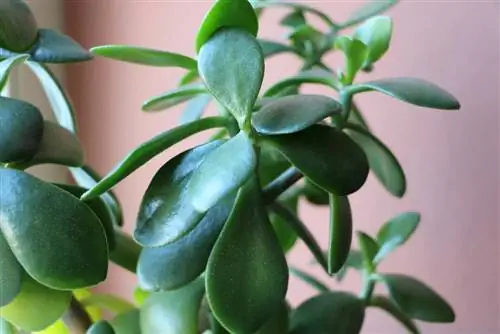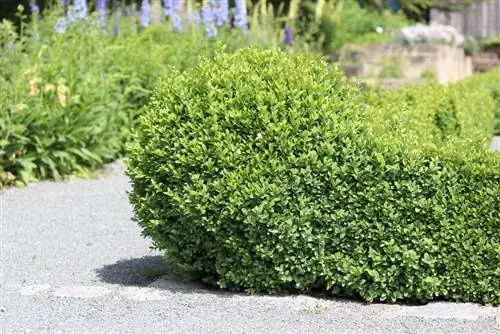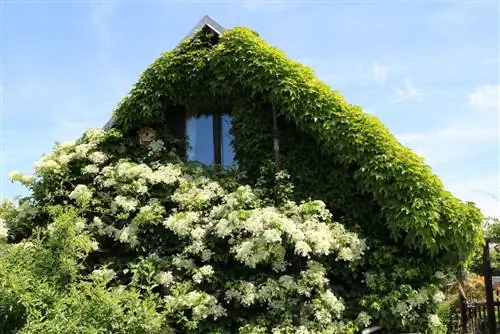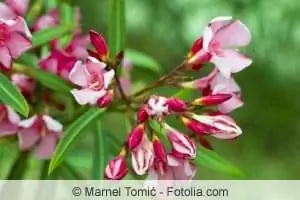- Author admin [email protected].
- Public 2023-12-17 03:39.
- Last modified 2025-06-01 06:48.
The Japanese have perfected the cultivation of small trees with their art of bonsai. But the trees for the terrace, for cozy garden corners or for the balcony don't have to be that small. Before you look for a suitable tree, a little know-how about the options and the care required can be helpful. Basically any tree can be cultivated in a pot. Exotic trees, native fruit trees, deciduous or coniferous trees, the selection is huge and everyone will find their own tree for the pot.
Selection and varieties
In order to find the right tree for you, it is advisable to first divide the trees according to their different requirements. But perhaps it has long been clear that it should definitely bear fruit, that it should be evergreen, that it should shed leaves or bear needles. The following variety and care tips will definitely make the selection easier. The relevant criteria, apart from taste and preference, are:
- Which location is planned?
- How much time or desire do I have for care?
- Where can I overwinter the tree if necessary?
A variety of trees and shrubs that were bred specifically for pots include, for example, the standard varieties, such as boxwood, roses and hibiscus. There are dwarf fruit trees or columnar fruit trees for almost every type of fruit for the snacking balcony. Numerous native deciduous and coniferous tree varieties have been specially bred as dwarf varieties for pots.
The nurseries almost exclusively offer exotic trees as container goods. For example, orange trees or oleanders. In winter, these heat-loving trees would only be able to survive outdoors in a few German regions.
Then there is the option of growing any tree in a planter when it is young. In the following period, of course, to keep it small. In a nursery, it is better to buy trees in a container for this purpose than to buy the plant with a root ball or even bare roots.
Growing your own from seeds or cuttings is also an inexpensive and labor-intensive way to enjoy a tree in a pot.
These tree varieties are particularly suitable for growing in containers:
Exotics, Mediterranean trees
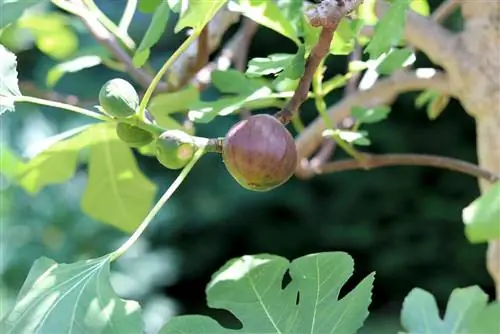
Fig tree (Ficus carica)
- conditionally hardy in warm regions of Germany
- Location: winter garden and house possible all year round, better outdoors
Pomegranate (Punica granatum)
- Can only tolerate cold up to 12 C°
- deciduous, can also overwinter in the dark (10-15C°)
Mandarin tree (Citrus reticulata)
- blooms several times a year
- bright, at 2°C to 10°C, hibernate
Calamondin orange (Citrofortunella mitis)
- small orange variety
- Winter quarters: the warmer the brighter; cool nights
Olive tree (Olea europaea)
- conditionally hardy in warmer regions of Germany
- evergreen, drupes (self-pollinated and cross-pollinated varieties)
Laurel tree (Laurus nobilis)
- overwinter at approx. 5°C with some light
- evergreen ornamental and spice leaves
Lemon tree (Citrus limon)
- wintering: bright in the room or cool and moderately bright
- evergreen, self-pollinator
- Particularly suitable variety for pot cultivation: Citrus aurantium, dwarf bitter orange, bergamot
Acerola (Malpighia glabra, Malpighia punicifolia)
- overwinter brightly and not below 15°C
- evergreen, bright red fruits
Deciduous trees
Various types of maple
- frost hardy
- deciduous, intensely colored autumn leaves
- slow growing
- Fan maple (Acer palmatum), fire maple (Acer tataricum subsp. ginnala), Japanese maple (Acer japonicum)
Gingerbread tree, Katsura tree, Japanese cake tree (Cercidiphyllum japonicum)
- hardy, needs a lot of light all year round
- 2 different shaped leaves, different coloring throughout the year
Magnolias different varieties
- not hardy in pots
- Large star magnolia (Magnolia loebneri), star magnolia (Magnolia stellata), purple magnolia (Magnolia liliiflora)
Conifers
Common Yew (Taxus baccata)
- Shaded location
- hardy
- branches after pruning
Spherical pine, dwarf pine (Pinus mugo)
- hardy down to -15°C in the pot
- very robust
- small varieties: 'Columnaris', 'Pumilio', 'Varella', arborvitae (Thuja occidentalis)
- hardy down to -10°C in the pot
- Suitable varieties: Thuja 'Golden Tuffet', Tuja 'Smaragd'
Juniper (Juniperus communis)
- hardy in pots
- good for topiary
- suitable varieties: rocket juniper (Juniperus scopulorum 'Blue Arrow' or 'Skyrocket'), squill dwarf juniper (Juniperus squamata 'Blue Star')
Spruce, fir
Christmas is a good opportunity to decide on a spruce or fir in a pot. These trees should not stay in the warm room for too long over the Christmas period. It is important to have water and sufficient humidity these days.
Acclimatization is important:
So slowly get used to the inside temperature and vice versa.
Suitable varieties: white spruce, dwarf sugarloaf spruce, single spruce, balsam fir
Fruit trees
Almond tree (Prunus dulcis)
- overwinter protected from frost
- relatively demanding in care
- very beautiful, early flowering
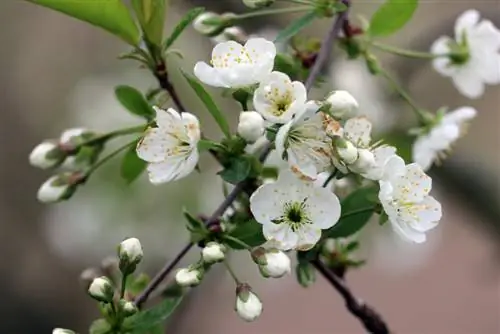
Apple tree (Malus domestica)
- pull from seeds and train into a container tree
- easiest for the pot: espalier, dwarf or columnar apple trees, e.g. B. - Dwarf apple tree (Malus domestica ‘Red Spur Delicious’)
Apricot tree (Prunus armeniaca)
- only conditionally hardy, needs protection in a pot
- Fruit-bearing: Columnar apricot well suited
Pear tree (Pyrus communis)
- lots of sun, little wind
- Cross-pollinator
- Fruit-bearing: dwarf varieties, columnar pear
True walnut (Juglans regia)
- winter brightly and frost-free
- very sensitive, difficult to cut
Dwarf trees, standard trees
If you are a beginner and decide to grow fruit trees or exotic plants on your terrace, you should use varieties that are already designed for cultivation in containers. These can be both special breedings and mutations. With these varieties you don't have to worry so much about keeping the tree small by cutting the crown and roots. These varieties are particularly slow growing. They are trained for particularly beautiful flowers, attractive foliage and, in the case of fruit-bearing trees, for a rich harvest.
Container trees
Popular species, especially for pot culture, include:
- Ball Ginkgo (Ginkgo biloba 'Mariken')
- Muscle cypress (Chamaecyparis obtusa 'Nana Gracilis')
- Dwarf Yew (Taxus cuspidata 'Nana')
- Dwarf pine (Pinus mugo pumilio)
- Columnar and dwarf fruits (apples, pears, cherries, plums, nectarines, peaches)
Shrubs as trees, tall stems
Small trees for the pot can also be grown from local shrubs such as hazel, dogwood, elderberry and viburnum. These variations can be purchased in many garden centers.
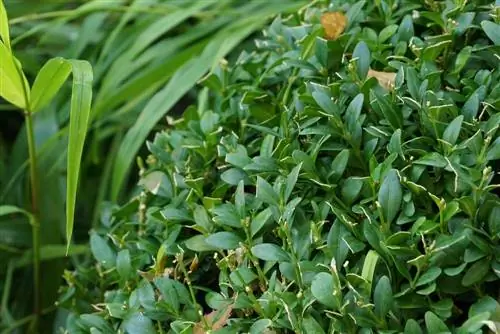
High stems are further varieties developed specifically for pot culture. You can get an elegant look on your terrace or balcony with these standard trees. Many of the flowering standard stems are available in countless varieties:
- Wisteria
- Privet
- Roses
- Camellia
- Conifer
- Eucalyptus
- Ilex
- Buchs
Care instructions for pots and buckets
The choice of pot depends on the tree, of course. So it is important to know from the outset whether it is a deep or shallow rooted plant. Accordingly, the vessel should either be particularly high or rather wide. Basically you let the planters grow with the trees. The size depends on the existing root size, i.e. a maximum of one and a half times the dimensions of the root ball.
The material of the pot, whether plastic or terracotta, doesn't really matter. If you choose a plastic container, keep in mind that the water has difficulty evaporating. Be careful when watering, because if waterlogged over a longer period of time, the roots begin to rot.
A clay or terracotta pot full of moist soil will be very heavy, depending on its size. So be careful if you want to put the tree, or even several, on the balcony. Later transport can also become almost impossible under certain circumstances. Stable, rolling coasters can help.
Another option is a stationary vessel made of concrete, stone or marble. The vessel must be high enough to ensure well-established drainage. Depending on the size of the tree you buy, it will of course have to be slowly brought up to this size.
Plants
In the nursery, small trees are offered in containers or with root balls. The bale goods are usually a lot cheaper than the potted trees. However, the latter have the advantage that they are already used to a pot and you can buy and plant them at any time. Baled goods should be purchased and planted promptly for potting in autumn or winter.
Before planting, give the tree a good jump-start to deal with the stress of moving by giving it a root bath for about an hour. The containers can be placed in a bucket of water. If you now have a suitable planter, substrate and drainage material ready, you can get started:
- Drainage layer of several centimeters, with gravel or pottery shards
- fill the pot 1/3 full with the appropriate substrate
- sound out the height, only set it as low as it was before (visible traces of soil on the trunk)
- detangle the roots lightly and gently beforehand
- insert and fill with soil
- if necessary, add a support without damaging the roots
- Fill the pot slightly, press the soil down a little with your hands
- water thoroughly
- Finally, to better retain moisture, a layer of mulch can be added
Substrate
The composition of the substrate must be tailored as best as possible to the needs of the tree. The quality must be higher than when planted outdoors. It's best to ask the dealer directly which substrate the tree prefers:
- more acidic or alkaline
- rather lean or nutrient-rich
- optimal admixture: with expanded clay, sand, peat, pumice, gravel
- Drainage layer
Repotting
Regular repotting is unfortunately unavoidable, especially in the first few years. The next larger container should be only slightly larger than the rooted part of the old pot. If the container was too large, the roots would immediately spread quickly. This then comes at the expense of the upper parts of the plant. In extreme cases, this can even cause the plant to die. When the tree has reached the desired size, it can no longer be given a larger container. Then, if necessary, some roots are trimmed and, above all, fresh soil is filled in. This action should be carried out every two years.
Tip:
Visible roots on the surface of the soil and at the drainage hole below are a sure indication that it is time to repot the tree. The best time to repot is after winter rest, in early spring.
Cut
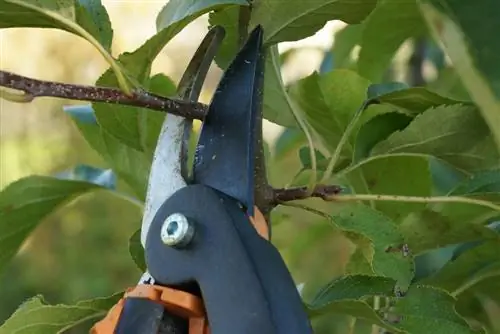
Pruning is more important for pot cultivation than for a tree in the open field. The crown should not be too large and disruptive, criss-crossing branches are more visually significant here than on a large tree. If you don't want the tree to grow any further, depending on the species, the roots can be professionally (!) pruned in some places. Procedure for pruning trees in container culture:
- Cutting work 1-3 times a year, in summer, late summer and spring
- Keeping the treetop in shape (compact, small)
- Remove runners, water shoots, dead branches
- It's better to cut a little more often than rarely and radically
- the cut always starts above a bud
- For branches that should be completely removed, directly at the base
Watering, fertilizing
A large tree outdoors forgives some care mistakes, especially when it comes to fertilization or watering. Not so with the tree in the pot. He depends on getting what he needs in a timely manner. A pot quickly becomes waterlogged or completely dry. Certain species also react very sensitively to calcareous tap water.
When it comes to fertilization, it is often too much that causes problems for the trees in planters. Here you should really make sure to use the right fertilizer in the correct dosage.
Depending on whether it is exotic, whether many flowers, fruits or many green leaves are important, the adequate balance of nitrogen, phosphate or potassium is crucial. The safest option is to give the tree a slow-release fertilizer once or twice a year.
Wintering
In the open field they can withstand the strongest frosts, but in the pot they rely on protective measures. Almost every tree in a container needs special protection in winter. During the cold season, exotic specimens are best kept bright, cool and frost-free in a winter garden or another bright, cool interior.
Most native plants can be overwintered outside in a sheltered place provided with bubble wrap, straw or jute sacks and a Styrofoam base.
Pests Diseases
Slightly easier than with an outdoor tree, but it is all the more important to check the small tree regularly for pests and diseases. The wrong substrate or care errors become noticeable more quickly than with trees in the wild. If recognized in time, you can almost always prevent the worst without using chemicals.
Propagation, breeding
With a little experimentation and significantly less cost, you can grow a potted tree yourself. In further care, repotting, root and crown care are very important in order to keep the tree beautiful and small at the same time.
It has recently become very popular, especially with tropical fruits, to grow a small tree from the seed or core. With a little skill and patience, you can do this quite well with avocado, mango and papaya, for example.
In the garden or in the great outdoors (attention: property, nature conservation!) there are often small seedlings that should be there the next time they mow anyway. This is a good opportunity to get a native potted tree. Small seedlings can also be grown from chestnuts and pine cones collected in autumn.
Another option is cuttings or cuttings from native trees and plants. The magnolia, the cornelian cherry and the almond tree are well suited for propagation using cuttings.
Conclusion
With so many options, you would like to start right away and put a shapely spruce or a productive apricot tree on your balcony. In principle, tree species that have already been grown in containers are easier to care for. But if you don't mind the effort and if you enjoy it, you can grow any tree into a medium-sized bonsai.

